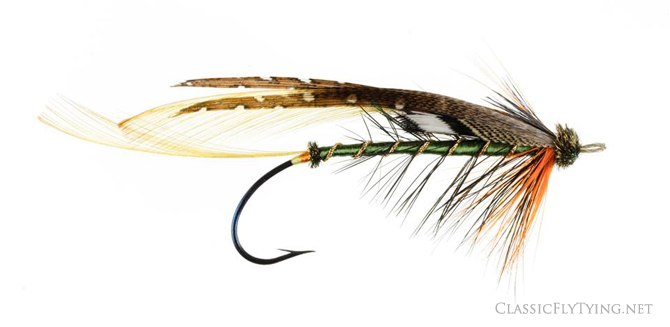Written by Andrew Herd, September 30, 2016. Published with permission.

Erin-go-Bragh, tied by Alberto Calzolari / hook by Ronn Lucas / photograph (c) Andrew Herd
Erin Go Stuttgart
This weekend we have a Blacker fly that none of us have ever seen dressed on the correct size of hook, but which we can show as it was intended to be tied, thanks to Alberto Calzolari and the amazing Mr. Ronn Lucas, master-hookmaker and a valued member of the Blacker team.
The Erin-Go-Bragh will be known to most of you because it is one of the flies featured in Ephemera’s (Edward Fitzgibbon) Book of the Salmon, which was published in 1850. This book had many Blacker flies in it and Ephemera originally intended to write it with Blacker as co-author, but the fly dresser fell ill and was unable to do more than provide the wonderful flies from which the plates were drawn. The challenge of tying the Erin-Go-Bragh is that Ephemera states that it should be tied on a hook ‘as long in the shank as a No. 3., but to be of finer wire, and as small in the bend as a No. 6. hook.’ Translating the hook scale that Ephemera dreamed up for the Book of the Salmon, this means a hook with a gape the size of a Phillips 9 and a shank the length of a Phillips 6, an iron which was unobtainable until Ronn rolled up his sleeves (once again, you cannot beat that man, no matter how hard you try, he is pure gold).
We are extraordinarily grateful to Ronn for his help, because if you dress this pattern on a standard hook, or a Long Dee, it just looks wrong. One feature of the fly which I am sure that a lot of you have noticed is the way the toppings fall below the Argus. This can be seen on the Ephemera plate and was something of a Blacker trademark—quite a few of the patterns in the 1843 edition are tied this way and it is seriously attractive.
There is an interesting story about where these long irons came from, and it turns out that they were based on an idea from Sir A. P. Gordon Cumming, who was one of the most experienced salmon rods in the land. Cumming thought that patterns dressed on the hooks would be more attractive to salmon, and they certainly worked, because three other Blacker patterns are known to have been tied on them, but Blacker had dropped the idea by 1855, maybe because they turned out to be poor hookers, as all these long irons are — they just lever out of the mouth of the fish. But they look great.
About the William Blacker Project.
This three volume trilogy is in the final stages of editing and will be published by the Medlar Press in 2016. The first volume will cover William Blacker’s life and times, the second will introduce the many different versions of Blacker’s 1842 and 1843 editions, and the third volume will list every pattern listed by or associated with William Blacker prior to 1855. All volumes will be in full colour and we promise to deliver a standard which will not so much raise the bar, but kick it out of sight.
You can read more about William Blacker on his Facebook page:

